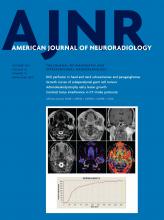We want to thank Drs Kadam and Dua for their thoughtful and interesting commentary on our article in a Letter to the Editor. We acknowledge that are different methods to evaluate the carotid artery (CA) position and define anatomic variations. The method used by the authors of the Letter to assess the CA position in relation to the uncovertebral joint by Koreckij et al1 is, in fact, more reproducible, faster, and simpler than the classification by Pfeiffer et al2 that we used in our article. Differences between the 2 methods are probably less scientific in nature than they are due to differences in perspective and operative approach between the orthopedic spine surgeons (Koreckij group) and head and neck surgeons (Pfeiffer group). Thus, Koreckij et al propose using the uncovertebral joint, a landmark in the spine, as the anatomic point of reference, whereas Pfeiffer proposes the pharyngeal wall, a landmark in the neck. On additional further review, 4 of 5 (80%) of our patients would qualify as having a retropharyngeal CA based on using the uncovertebral joint. Because we are a group of endocrine surgeons and a radiologist specializing in parathyroid disease, we used the classification based on the pharyngeal wall because this is more easily assessed in our surgical field than the uncovertebral joint.
We agree with the authors that age and sex are potential confounders that cannot be fully analyzed in a case series of 5 patients. However, the average patient for primary hyperparathyroidism is a 62-year-old woman (affecting women 3 times more often than men); therefore, a case series of 5 women older than 60 years of age is not unique in this patient cohort. Additionally, although posteriorly located upper adenomas are rather common, accounting for 45% of all single gland adenomas, they are often located in the paraesophageal space or tracheoesophageal groove.3 True, ectopic retroesophageal adenomas are rarer, accounting for only 6.7% of all parathyroid adenomas, the second most common ectopic location (the first is the cervical thymus) to the cervical thymus.4 We agree that to definitively analyze whether there is a true association between kissing carotids and retroesophageal adenomas, a case-control study comparing the incidence of retroesophageal adenomas in all patients with primary hyperparathyroidism with that in those patients with kissing carotids is required. Unfortunately, given the overall low incidence, it is unlikely that a study can be conducted with enough power to determine the association.
Thus, the intention of our article was not to actually prove this association, but to highlight this potential association between kissing carotids and retroesophageal adenomas that we noted among these 5 patients. Even though the association cannot be proved statistically, we believe that given the much higher risk of morbidity with re-operative parathyroidectomy, any guidance that can facilitate successful localization of ectopic parathyroid adenomas before the first exploration can be helpful.
- © 2021 by American Journal of Neuroradiology












